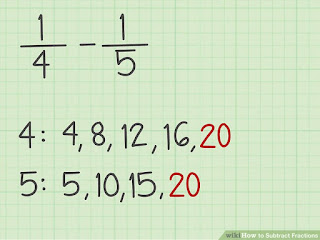Tremendous Thursday!
We began the day with math. Today we focused on subtracting fractions.
1
List multiples of the denominators if necessary. If the denominators of your fractions aren't the same, you'll need to make them the same. List the multiples of each denominator so you can find a number that both denominators have in common. For example, if you're doing 1/4 - 1/5, list all the multiples of 4 and 5 to find 20.
· Since the multiples of 4 include 4, 8, 12, 16, 20 and the multiples of 5 include 5, 10, 15, and 20, 20 is the lowest number they have in common.
· If the denominators are already the same, you can skip straight to subtracting the numerators.
2
Multiply both the numerator and denominator to get like denominators. Once you've found the lowest common multiple for your unlike fractions, multiply the fraction so the denominator becomes the least common multiple.
· For example, multiply 1/4 by 5 to get a denominator of 20. You'll also need to multiply the numerator by 5, so 1/4 becomes 5/20.
3
Make equivalent fractions for all of the fractions in the equation. Keep in mind that if you adjust 1 of the fractions in the problem, you'll need to adjust all of the fractions so they're equivalent.
· For example, if you've adjusted 1/4 to become 5/20, multiply the 1/5 by 4 to get 4/20. The original problem 1/4 - 1/5 becomes 5/20 - 4/20.
4
Subtract the numerators and keep the denominator the same. If you started with denominators that were the same or you made equivalent fractions with the same denominator, subtract the numerators. Write the answer and then write the denominator underneath it.
· Remember not to subtract the denominators as well.
· For example, 5/20 - 4/20 = 1/20.
5
Simplify your answer. Once you have your answer, check to see if you can simplify it. Find the greatest common factor of the numerator and denominator and divide both numbers by it. For example, if you had an answer of 24/32, the greatest common factor is 8. Divide both numbers by 8 to get ¾.
· Depending on your answer, you may not be able to simplify it. For example, 1/20 can't be reduced further.
Next, we had French.
After first recess and lunch we discussed chapters 18 and 19 of Tuck Everlasting.
Then we continued working on our Powtoon about our chosen Aboriginal group.
After second recess and lunch we had physical education. Some of us chose to stay behind to continue working on our Powtoon.
Homework:
1. Read Chapters 18 and 19 and complete pages 48-51
2. Math Sheets
3. Finish Powtoon





No comments:
Post a Comment